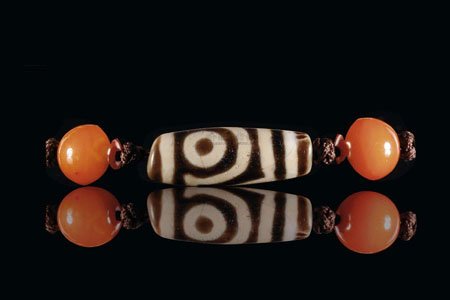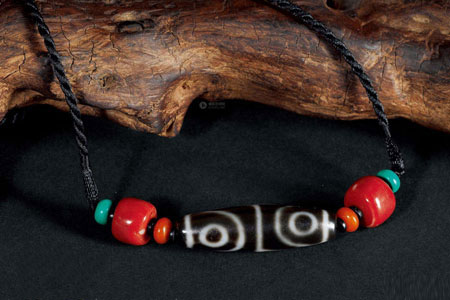Natural Dzi Bead Identification, What are the identification methods of natural Dzi Beads?
Tianzhu is the first of the seven treasures of the Tibetans. It is a gem with legendary and ancient cultural significance. The earliest Tianzhu is called Xiangxiong Dzizhu. It is enshrined by the great achievers and Gaodai Dade for the Buddha or the handed down. From now on, the existing (old) Dzi Beads are all remains of the ancients, rare and rare. Xiangxiong Dzi Bead is the oldest and purest dZi in the present. It is a rare and rare treasure. The following is a small series of China Jewelry Merchants Network to introduce the identification of natural Dzi Beads. The identification of Dzi Beads can be used for the initial review with the "six look", as follows. 1. Look at the texture of the Dzi Beads Observed from the liberation of minerals, the color of various minerals can be divided into the original inherent color called white; the color caused by the mixed pigment ions is called other color; the color caused by cracks is called false color, which is mineralogy The three colors of the texture. The color of the Dzi Beads is roughly divided into five types: milky white, black, brown, red and light green. Among them, the texture of milky white is the best. Some Dzizhu researchers have included the milky white in the hole of the Dzi Bead. One of the prerequisites for silkworm mulberry is to identify it from the texture. 2, look at the color of the dZi Dzi Beads are generally black, white, dark brown and milky white. The black and white lines are also one of the first choices for many people. 3, see the luster of the dZi The so-called surge refers to the intensity of the surface reverse light, the reflectivity is large, and the surge is strong. Generally, the surge can be divided into: glass luster, grease luster, waxy luster and earthy luster. Due to the long-term natural weathering, the surface of the Dzi Beads is relatively unsmooth and the reflected light is disordered. The surface of the Dzi Bead is coated with a layer of grease. This gloss is called grease luster. Some greases are particularly bright, which can be called waxy luster. Some of the dZi are fire-baked, the surface is grayish white, and there is some kind of trap on the light, which is dull and dull. This situation is called earthy luster. 4, see the integrity of the Dzi Beads Observing the integrity of the entire dZi from the outside is the most direct and effective. Because of the age of the old Dzi Beads, it is quite difficult to find a perfect and flawless Dzi Bead. Therefore, the wear of the slanted face at both ends of the Dzi Bead does not affect its integrity. In general, a small part of the damage other than the handed down product may be used for Buddha packaging or milling, and should be acceptable. As for the dZi that breaks into a half or is severely damaged, it has lost its effect and should not be collected. The new imitation Dzi Beads are generally intact, and their slopes have traces of “mutilationâ€, so be especially careful. 5, look at the cinnabar point of the Dzi Beads The so-called cinnabar point is a kind of red spot, which grows naturally from the inside to the outside of the beads of the Dzi Beads. But not every celestial jewel has a cinnabar point, nor does it mean that the cinnabar point is a good product. . It is only one of the signs for judging the old and new Dzi Beads, just like the "corpse spot" in the old jade ("the ancient"). This red spot may have been formed by the fusion of the magnetic beads of the Dzi Bead and the human body. Because jade itself has permeability, it may also be scratched and scratched, so that it can be infiltrated into the celestial body and gradually form a "blood spot". 6, see the patina The patina is not the dirt on the beads. It is a kind of attachment of acid, alkali, molecules and body branching. It is washed and can not be scraped, just like the old porcelain, the patina on Ming and Qing furniture. . This kind of palate is smooth and natural, and any old can not be made into this naturally formed patina. "Nature is old" and "human work is old" is not the same. The crippling of years is a kind of beauty, artificial "Doing the old and doing the old" is getting more and more ugly. Many of the agate beads on the artificial Dzi Bead market, whether the public opinion comes from the origin of Tibet, are all claimed to be "Tibetan Dzi Beads". The old gods are worshipped by the incense. The rest is called New Dzi Beads. There are also the claims of type one and type two. The former is tens of thousands, while the latter is only a few hundred yuan. But it is harder to buy a real millennium, which is handed down in Tibet, because the Tibetan people of the Tibetan people do not sell it. The Dzi Beads are a symbol of identity in the eyes of Tibetans. Only sacred people can wear them. Therefore, the Tibetans will present the Dzi Beads to represent him and respect you very much. 13372,cotton,beddingset Nantong NATASHA Textiles Co.,Ltd. , https://www.ntnatashatextile.com
